Table of Contents
ToggleThiruvannamalai Temple: The Sacred Abode of Lord Shiva in Tamil Nadu

Introduction to Thiruvannamalai Temple
Nestled at the foothills of the majestic Arunachala Hills in Tamil Nadu lies one of the holiest and most revered Shiva temples in India — the Thiruvannamalai Temple, also known as the Annamalaiyar Temple. Dedicated to Lord Shiva, who is worshipped here in the form of Agni (fire)—one of the five elements of nature—this temple is not just a site of ritual worship but a beacon of deep spiritual energy and devotion. For centuries, pilgrims, saints, and spiritual seekers from all over India and abroad have been drawn to this sacred space in search of divine connection, inner peace, and liberation.
Spanning over 25 acres, Thiruvannamalai Temple is one of the largest temple complexes in India. Its towering Rajagopuram (main entrance tower), which rises to about 66 meters, is a remarkable example of Dravidian temple architecture, and its sculptural richness narrates tales from Hindu mythology and Shaivite tradition. The temple complex houses several shrines, sacred tanks, pillared halls, and intricately carved mandapams, making it a treasure trove for devotees, historians, and art lovers alike.
But what makes this temple truly unique is its spiritual significance. According to Hindu legend, this is the site where Lord Shiva manifested himself as an infinite column of fire, challenging Lord Vishnu and Lord Brahma in a divine contest of supremacy. This fiery form of Shiva, called Arunachaleswarar, symbolizes his formless, eternal nature. As a result, Thiruvannamalai is considered the embodiment of Agni (fire) among the Pancha Bhoota Sthalams—the five temples representing the five elements (earth, water, fire, air, and ether).
Another hallmark of the temple is the sacred ritual of Girivalam—the 14-kilometer circumambulation around the Arunachala Hill, which is considered to be Shiva himself. Devotees undertake this spiritual walk, especially on full moon days, with barefooted devotion, chanting prayers, and stopping at the numerous shrines and lingams placed along the path. It is believed that completing the Girivalam with pure intention cleanses one’s karma and leads to spiritual awakening.
The spiritual magnetism of Thiruvannamalai has attracted countless sages and saints, including the revered Sri Ramana Maharshi, who spent his life in meditation at the foot of the Arunachala Hill. His ashram, located nearby, continues to draw seekers from around the world.
Festivals at the Thiruvannamalai Temple are grand and spiritually uplifting. Among the most important is the Karthigai Deepam, where a massive flame is lit atop the Arunachala Hill, symbolizing the divine light of Shiva. Witnessed by lakhs of devotees, this event marks the climax of ten days of celebration and is an awe-inspiring spiritual spectacle.
Beyond its religious significance, the temple is a cultural and historical landmark. It reflects the architectural styles of various dynasties, including the Cholas, Pandyas, Hoysalas, and the Vijayanagara Empire. Each structure within the temple tells its own story through inscriptions, murals, and sculptures that chronicle centuries of devotion and temple administration.
In today’s fast-paced world, Thiruvannamalai Temple stands as a timeless sanctuary. Whether you’re a devoted pilgrim, a spiritual seeker, or a curious traveler, the experience of standing before the flame of Arunachaleswarar is humbling, healing, and transformative.
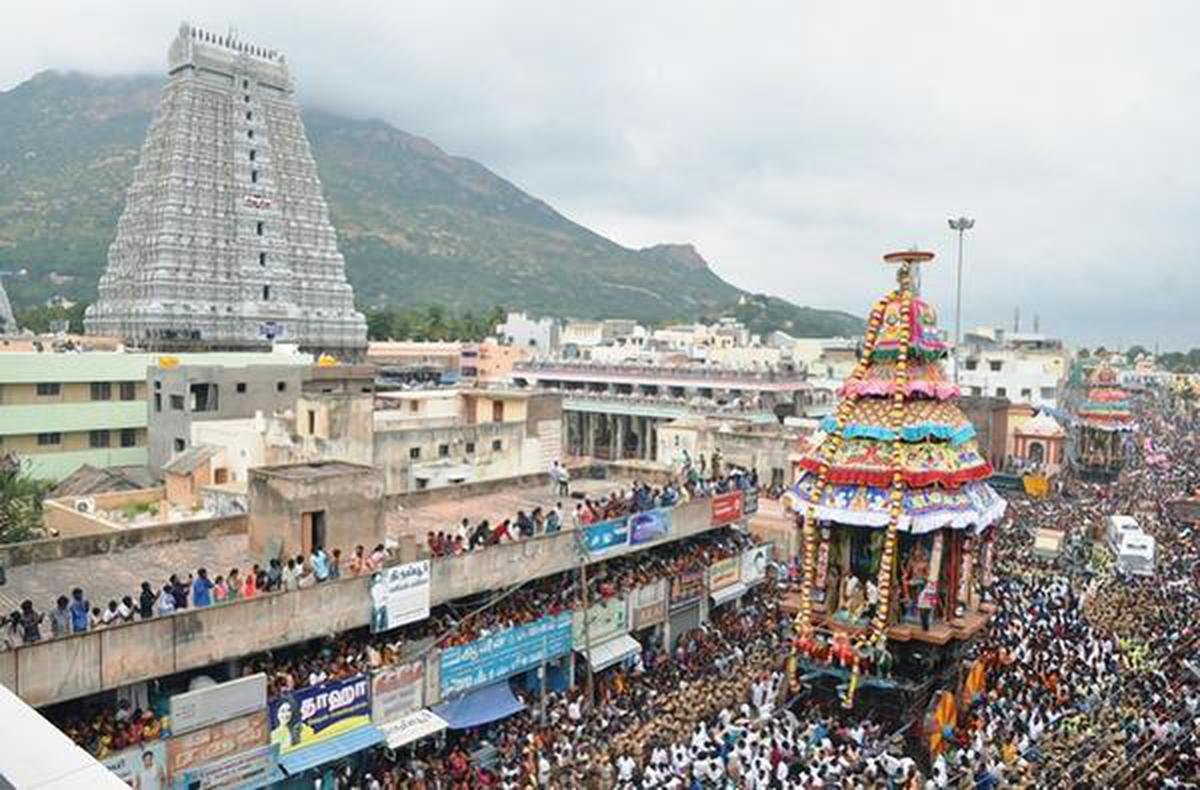
Mythological Significance and Spiritual Beliefs
Mythological Significance and Spiritual Beliefs
The Thiruvannamalai Temple, dedicated to Lord Shiva in the form of Arunachaleswarar, holds deep roots in Hindu mythology and is considered one of the most sacred Shaivite sites in India. Its mythological importance is tied to one of the most profound stories from the Puranas, symbolizing the divine essence of humility, truth, and transcendence.
The Legend of the Endless Flame
The most well-known myth associated with Thiruvannamalai is the “Lingodbhava” legend. According to the Skanda Purana, once a debate arose between Lord Vishnu and Lord Brahma about who among them was the greatest. To resolve the argument, Lord Shiva appeared before them as a massive column of fire—a form that had no beginning or end. He challenged them to find the limits of this fiery form.
Lord Vishnu took the form of a boar (Varaha) and tunneled deep into the earth to find the bottom, while Brahma transformed into a swan and soared upward in search of the top. Vishnu, after a long search, accepted his defeat and praised Shiva’s greatness. Brahma, however, falsely claimed he had reached the top, bringing a Ketaki flower as false witness. Enraged by the lie, Shiva cursed Brahma that he would never be worshipped in temples—a tradition that continues to this day.
This story is not just a tale of divine rivalry but a spiritual metaphor. It represents the infinite and formless nature of the Supreme, which cannot be measured or understood by ego or intellect.
Arunachala Hill as Shiva Himself
What makes Thiruvannamalai uniquely sacred is the belief that the Arunachala Hill itself is a manifestation of Lord Shiva in the form of Agni (fire). Devotees believe that this hill is not separate from the deity—it is the deity. This belief forms the basis for the sacred practice of Girivalam (circumambulation) around the hill, especially on full moon nights and during the Karthigai Deepam festival.
Performing Girivalam is considered an act of devotion and surrender, believed to wash away past sins, remove karmic blocks, and lead to spiritual liberation. Devotees walk barefoot for 14 kilometers around the hill, stopping at numerous sacred shrines along the way.
A Center for Spiritual Awakening
The spiritual vibrations of Thiruvannamalai have attracted countless saints and siddhas over the centuries. Among the most revered is Sri Ramana Maharshi, who realized the Self at a young age and spent his life in the presence of Arunachala. For him, the hill was the eternal Guru, and many of his teachings were born in its divine presence. His ashram continues to draw seekers from all over the world, further cementing Thiruvannamalai’s status as a spiritual epicenter.
A Sacred Symbol Beyond Religion
Thiruvannamalai is not just a temple town it is a living spiritual field. The legends associated with it, especially the story of the infinite flame, are symbolic of inner awakening teaching us that the ultimate truth lies beyond name, form, and ego. It reminds devotees that only humility, devotion, and surrender can lead to realization of the Divine
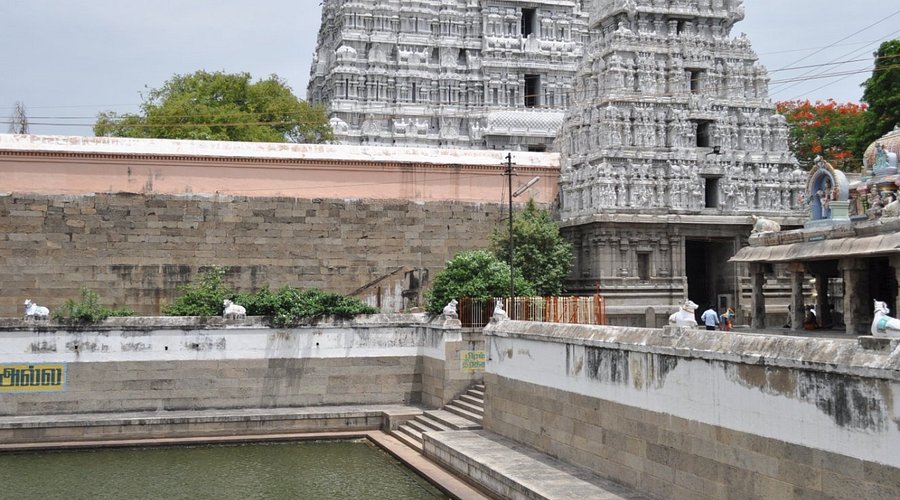
History of the Annamalaiyar Temple
History of the Annamalaiyar Temple
The Annamalaiyar Temple in Thiruvannamalai is one of the most ancient and historically rich temples in South India. With its origins rooted in antiquity, the temple has stood as a timeless witness to the cultural, political, and spiritual evolution of the Tamil region for over a millennium. Dedicated to Lord Shiva, who is worshipped here as Arunachaleswarar, the temple has been shaped by the devotion of saints, the patronage of kings, and the resilience of the local people.
Ancient Origins
Though the exact date of the temple’s origin remains unclear, references to Thiruvannamalai appear in ancient Tamil literature such as the Tevaram hymns sung by Saivite saints Appar, Sambandar, and Sundarar during the 7th–8th centuries CE. These saints praised the Arunachaleswarar Temple as one of the holiest Shiva shrines, indicating that the temple existed in some form during the early medieval period.
The original structure was likely modest and gradually expanded over the centuries into the grand complex we see today.
Chola and Pandya Contributions
Much of the temple’s structural development took place during the rule of the Chola dynasty (9th–13th centuries CE). The Cholas, great patrons of Shaivism, renovated the temple, added granite walls, gopurams (gate towers), and mandapams (pillared halls), and provided endowments for daily worship and festivals.
Later, the Pandyas also contributed to the temple’s growth, adding to its architectural splendor and religious rituals.
Vijayanagara Empire and Expansion
The most significant phase of expansion came during the Vijayanagara Empire (14th–16th centuries). Under rulers like Krishnadevaraya, the temple was transformed into a majestic complex. The towering Eastern Rajagopuram, standing at around 66 meters (216 feet), was constructed during this era and remains one of the tallest temple towers in India. The vast temple tank, Kalyana Mandapam, and Thousand Pillar Hall were also added during this time.
The Vijayanagara kings not only developed the temple’s physical structure but also institutionalized many of the rituals and festivals that are still followed today.
🇮🇳 Later Dynasties and Colonial Period
After the decline of the Vijayanagara Empire, the temple came under the control of local Nayaks, followed by Maratha and British rule. Though the British maintained minimal interference in temple affairs, they documented its architectural and religious significance. Several parts of the temple were restored during the colonial period.
Despite the political changes, the temple remained a vibrant center of spiritual life, drawing devotees and ascetics alike.
A Living Legacy
Today, the Annamalaiyar Temple is managed by the Hindu Religious and Charitable Endowments Department of Tamil Nadu. It remains a hub of intense religious activity, especially during Karthigai Deepam, Mahashivaratri, Pournami Girivalam, and other temple festivals.
The history of this temple is not just a chronicle of kings and dynasties
it is a living history of devotion, shaped by countless generations of devotees, poets, and sages. Its enduring presence continues to inspire awe and reverence, reminding visitors of the unbroken spiritual energy that flows through Thiruvannamalai.
Architectural Marvel of the Temple Complex
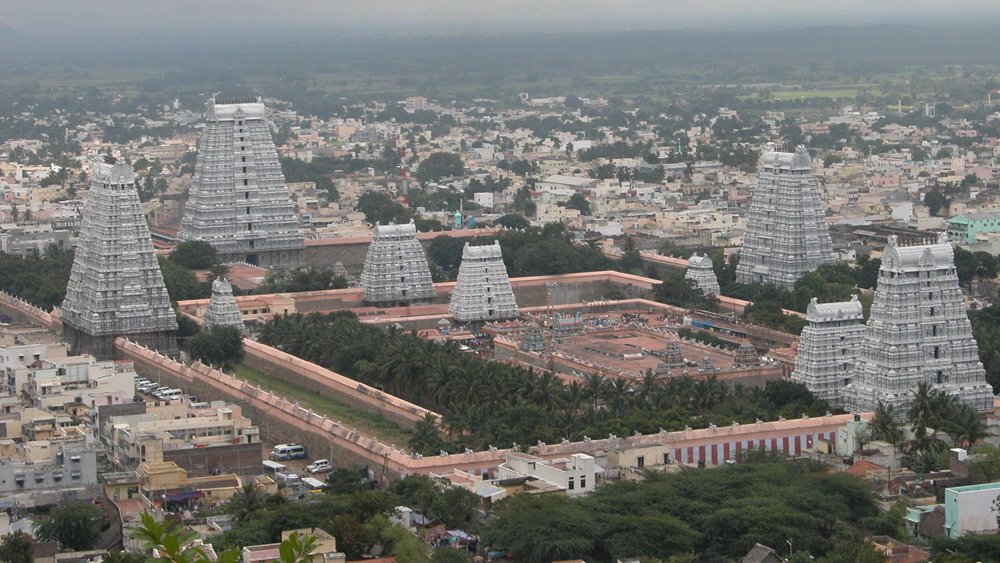
Architectural Marvel of the Temple Complex
The Annamalaiyar Temple in Thiruvannamalai stands as one of the finest and most massive examples of Dravidian temple architecture in South India. Spanning over 25 acres, the temple complex is not only a center of spiritual importance but also an architectural wonder that reflects the artistic brilliance and engineering excellence of Tamil civilization through various dynastic eras.
Monumental Gopurams (Entrance Towers)
The temple features four majestic gopurams (gateway towers), each oriented toward a cardinal direction. The Eastern Rajagopuram is the tallest and most iconic, rising to a height of 66 meters (216 feet) with 11 tiers. Constructed during the Vijayanagara period, this gopuram is one of the tallest temple towers in India and can be seen from several kilometers away.
Each gopuram is richly decorated with intricately carved sculptures depicting mythological scenes, divine beings, celestial dancers, and epic stories from Hindu lore. These towers serve both as architectural marvels and as gateways between the material and spiritual realms.
Sanctum and Inner Prakarams
At the heart of the temple lies the garbhagriha (sanctum sanctorum), where Lord Shiva is worshipped as Arunachaleswarar, represented by a Shiva Lingam. The sanctum is simple yet powerful, radiating a divine stillness. Just behind the sanctum is the shrine of Unnamulai Amman, the consort of Shiva.
The temple is surrounded by multiple prakarams (enclosure corridors), each lined with pillared halls, mandapams, and sub-shrines. These prakarams facilitate ritual circumambulation and are designed to represent different stages of spiritual evolution.
Hall of a Thousand Pillars & Other Mandapams
The Thousand Pillar Hall (Aayiram Kaal Mandapam) is another architectural highlight. Built by the Vijayanagara kings, this hall is used during temple festivals and cultural performances. Each pillar is beautifully carved with yalis (mythical lion creatures), gods, and dancers, showcasing the exquisite stonework typical of the era.
Other notable mandapams include:
Kalyana Mandapam – used for celestial wedding ceremonies.
Deepa Darshana Mandapam – a spot for lighting ceremonial lamps.
Vahana Mandapam – where the deity’s mount is kept during processions.
Temple Tanks and Sacred Spaces
The temple contains several sacred tanks, the largest being the Brahma Theertham, used for ritual purification. There are also other theerthams (holy water bodies), such as Shiva Ganga Theertham, believed to cleanse devotees of sins when bathed in or even viewed with faith.
Many smaller shrines dedicated to various forms of Shiva, Parvati, Ganesha, Murugan, Vishnu, and Navagrahas are spread throughout the complex, each with unique carvings and architectural features.
A Living Structure Through Centuries
Built and expanded over many centuries by the Cholas, Pandyas, Hoysalas, Vijayanagara kings, and Nayaks the architecture of the Annamalaiyar Temple is a layered testimony to Tamil Nadu’s rich cultural past. Despite its vastness and age, the temple remains well-preserved and fully active, housing vibrant rituals and festivals that draw millions.
Every stone, sculpture, and step in the temple tells a story of devotion, artistic mastery, and spiritual pursuit making the Thiruvannamalai Temple a masterpiece that is as much divine as it is architectural.
Karthigai Deepam Festival – The Flame of Faith
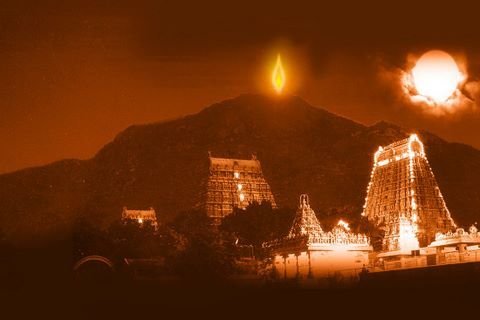
The Karthigai Deepam Festival is one of the most sacred and spectacular celebrations held at the Thiruvannamalai Temple, drawing lakhs of devotees from all over India and beyond. Also known as the Festival of Lights of Tamil Nadu, Karthigai Deepam is deeply rooted in both mythology and spiritual symbolism and is celebrated with profound devotion and grandeur.
This festival is dedicated to Lord Shiva in his form as Arunachaleswarar, the embodiment of Agni (fire), one of the five elements of nature. It symbolizes the triumph of divine light over darkness and ignorance and is regarded as a spiritual awakening for devotees.
The Mythological Significance
The origins of the festival lie in the Lingodbhava legend, where Lord Shiva appeared as an infinite pillar of fire before Brahma and Vishnu to end their dispute over supremacy. Neither could find the beginning nor end of this pillar, symbolizing Shiva’s formless, eternal nature. In remembrance of this cosmic event, the Karthigai Deepam flame is lit atop the Arunachala Hill, which itself is considered the embodiment of Shiva in fire form.
When and How It Is Celebrated
Karthigai Deepam falls in the Tamil month of Karthigai (mid-November to mid-December), usually on the full moon day (Pournami) when the Krittika Nakshatra coincides. The festival is observed for 10 days at the Annamalaiyar Temple, beginning with Dwajarohanam (flag hoisting) and culminating with the grand lighting of the Mahadeepam.
The Grand Lighting of Mahadeepam
On the final day of the festival, a massive cauldron filled with ghee (clarified butter) is carried to the summit of Arunachala Hill, over 800 meters high. A huge wick, soaked in ghee, is placed in the cauldron and lit precisely at sunset. This Mahadeepam is visible for miles and is revered as a physical manifestation of Shiva’s cosmic fire form.
As the flame is lit, temple bells ring, mantras are chanted, and lakhs of devotees gathered below chant “Annamalaiyarukku Arohara!” (Glory to Lord Annamalaiyar). The atmosphere becomes electrified with devotion, and people light rows of oil lamps (deepams) in their homes, streets, and temples.
Spiritual Importance of Girivalam During Karthigai
The act of Girivalam, or circumambulating the Arunachala Hill barefoot, gains even more spiritual significance during Karthigai Deepam. Devotees walk the 14-kilometer path around the hill, stopping at sacred shrines and lingams along the way. It is believed that performing Girivalam on this day destroys sins and grants moksha (liberation).
A Festival of Faith, Light, and Unity
Karthigai Deepam is more than just a religious ritual—it is a festival of inner light. It symbolizes burning away ego, ignorance, and karma, and embracing the pure flame of truth and self-realization. Even those who are not followers of Shaivism are deeply moved by the sheer scale and spiritual depth of the celebration.
Families in Tamil Nadu also celebrate this festival at home by lighting rows of clay lamps, decorating entrances with kolams (rangoli), preparing sweets, and offering prayers. It fosters a sense of unity, purity, and renewal in both the household and community.
An Unforgettable Experience
For visitors, witnessing Karthigai Deepam at Thiruvannamalai is a once in a lifetime experience. The energy of the place, the chants of thousands, the glowing hilltop flame, and the waves of devotion sweeping through the town are unforgettable. It’s not just a festival; it’s a spiritual journey into the light of Lord Shiva himself.
How to Reach Thiruvannamalai Temple

How to Reach Thiruvannamalai Temple
The Thiruvannamalai Temple, also known as Annamalaiyar Temple, is located in Thiruvannamalai district of Tamil Nadu, at the foothills of the sacred Arunachala Hill. It is well-connected by road, rail, and nearby airports, making it accessible to both domestic and international pilgrims.
By Road
Thiruvannamalai is easily reachable via road from major cities in Tamil Nadu and neighboring states. State-run and private buses operate regularly.
From Chennai – 200 km via NH 48 (approx. 5–6 hours)
From Vellore – 85 km (approx. 2 hours)
From Bengaluru – 210 km (approx. 5 hours)
From Puducherry – 100 km (approx. 2.5 hours)
From Tiruvannamalai Bus Stand – The temple is about 1.5 km, easily walkable or accessible by auto-rickshaw.
Tip: During festivals like Karthigai Deepam, buses run more frequently, but it’s best to book early due to high demand.
By Train
The Thiruvannamalai Railway Station (TNM) is well connected to several major towns and cities across South India.
Direct trains from Chennai, Bengaluru, Vellore, and Villupuram are available.
Major trains include:
Tiruvannamalai Express
Villupuram–Katpadi Passenger
From the station, the temple is just 2–3 km away, and auto-rickshaws or taxis are easily available.
By Air
While Thiruvannamalai does not have its own airport, it is accessible from the following nearby airports:
Chennai International Airport (MAA) – Approx. 200 km
Best choice for international and domestic travelers.
Puducherry Airport (PNY) – Approx. 100 km
Limited flights, but convenient for domestic travelers.
Bengaluru International Airport (BLR) – Approx. 215 km
Good for those coming from Karnataka or western India.
Tirupati Airport – Approx. 160 km
From these airports, you can hire a taxi or take a bus/train to Thiruvannamalai.
Travel Tips:
Best Time to Travel: November to March is ideal, especially during Karthigai Deepam and Full Moon Days for Girivalam.
Advance Booking: Always book transportation and accommodation in advance during major festivals.
Local Transport: Auto-rickshaws, cycle rickshaws, and taxis are widely available. You can also rent two-wheelers locally.
Language Note: Tamil is widely spoken, so a basic translation app or guide can be helpful for non-Tamil speakers.
Best Time to Visit and Temple Timings
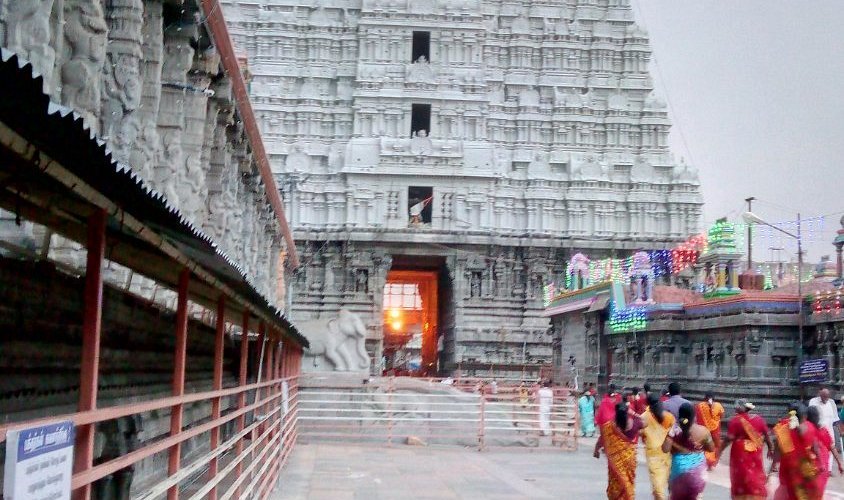
Best Time to Visit Thiruvannamalai Temple
The ideal time to visit the Annamalaiyar Temple depends on both the climate and religious festivals. Here’s a guide to help you plan your pilgrimage effectively:
Pleasant Season (October to March) – Best Time
Weather: Cool, comfortable (20°C to 30°C)
Why Visit: Ideal for temple exploration, Girivalam, and spiritual retreats.
Major Festivals:
Karthigai Deepam (Nov–Dec): The grand flame-lighting festival on Arunachala Hill.
Arudra Darshan, Maha Shivaratri, and Pournami Girivalam also happen during this season.
Recommendation: Make advance hotel and travel bookings during this peak period.
Moderate Season (July to September) – Off-Peak but Decent
Weather: Slightly humid with occasional rains.
Why Visit: Less crowded, serene atmosphere.
Activities: Peaceful darshan, meditation, and light trekking around Arunachala Hill.
Hot Season (April to June) – Not Ideal
Weather: Very hot (35°C to 42°C)
Why Avoid: Intense heat makes outdoor walking and Girivalam difficult.
Tip: If visiting in summer, plan temple visits early in the morning or after sunset.
Annamalaiyar Temple Timings
The temple is open daily for devotees, with specific hours for darshan, poojas, and rituals.
| Day | Opening Hours | Break Time | Evening Hours |
|---|---|---|---|
| Mon–Sun | 5:30 AM – 12:30 PM | 12:30 PM – 3:30 PM | 3:30 PM – 9:30 PM |
Major Daily Poojas and Rituals:
| Pooja Name | Timing |
|---|---|
| Ushakalam Pooja | 5:30 AM |
| Kalasanthi Pooja | 8:00 AM |
| Uchikalam Pooja | 10:30 AM |
| Sayaraksha Pooja | 5:30 PM |
| Irandam Kalam Pooja | 7:30 PM |
| Arthajama Pooja | 9:00 PM |
Note: During special occasions and full moon days, the temple remains open for extended hours and accommodates Girivalam pilgrims walking around Arunachala Hill.
Tips for Devotees
Arrive early to avoid queues during peak hours.
Dress modestly and remove footwear before entering.
Try attending at least one pooja for a spiritually enriching experience.
Full moon nights are extremely crowded due to Girivalam – reach the temple well in advance.
Tips for First-Time Visitors to Thiruvannamalai Temple
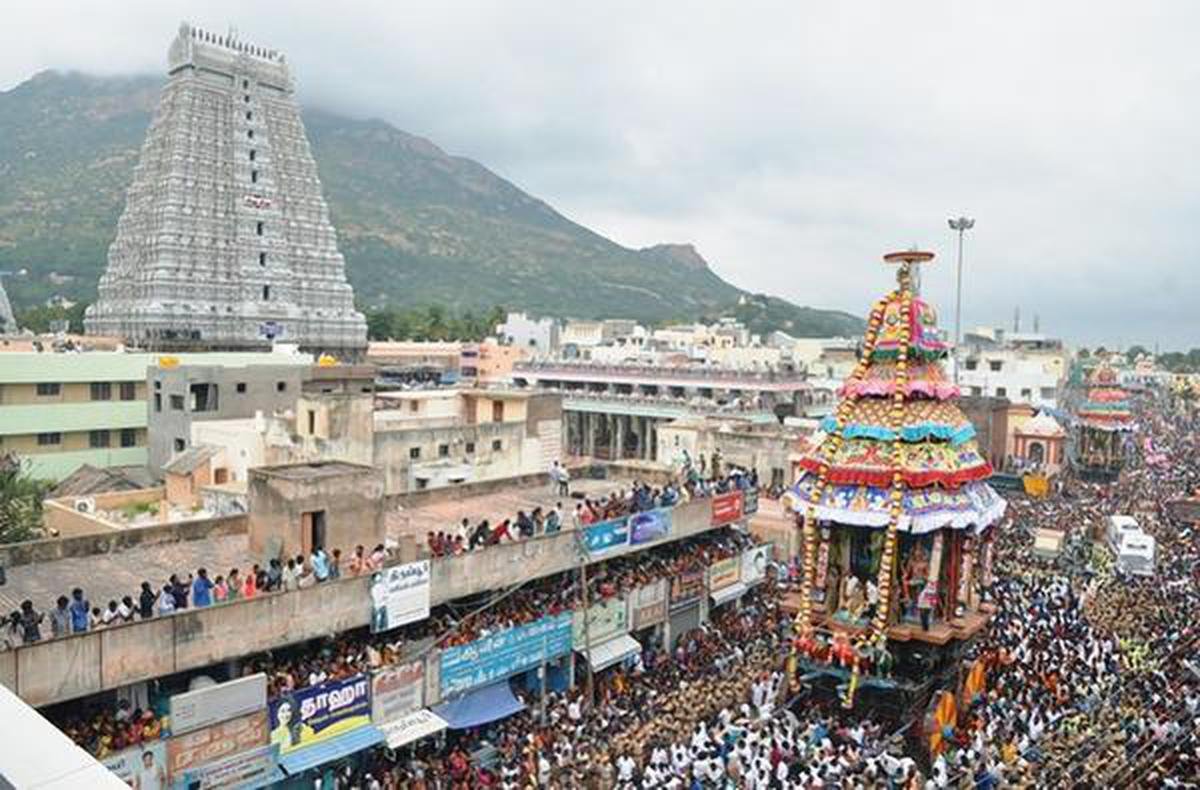
Visiting the Annamalaiyar Temple in Thiruvannamalai is a deeply spiritual experience. Whether you’re coming for a quiet darshan, Girivalam, or a major festival like Karthigai Deepam, a few practical tips can help first-time visitors make the most of their trip.
1. Plan Your Visit During the Right Season
Best time: October to March – pleasant weather and major festivals.
Avoid the summer months (April to June) due to extreme heat, especially if planning Girivalam.
2. Visit the Temple Early
Arrive by 5:30 AM to avoid long queues and experience the peaceful morning atmosphere.
Evening hours (after 6 PM) are also ideal, especially during hot days.
3. Respect Temple Customs and Dress Modestly
Wear traditional or modest clothing: sarees, salwar kameez, dhotis, or full pants.
Sleeveless tops, shorts, or western outfits may not be allowed inside sanctum areas.
Footwear must be left at designated areas before entering the temple.
4. Participate in a Pooja or Aarti
Attending even one of the daily six poojas offers a more meaningful spiritual connection.
The early morning pooja (Ushakalam) or evening Sayaraksha pooja is recommended.
5. Experience Girivalam (Circumambulation)
Walk the 14-km Girivalam path barefoot around Arunachala Hill, especially on full moon nights.
It’s believed to cleanse karma and bring spiritual blessings.
Carry water, wear comfortable clothing, and walk in a group if possible.
6. Stay Hydrated and Eat Light
Carry bottled water and avoid heavy meals before temple visits or Girivalam.
Plenty of vegetarian eateries and tiffin centers are available near the temple.
7. Book Accommodation in Advance
During festivals like Karthigai Deepam or Shivaratri, hotels fill up quickly.
Choose guest houses near the temple or along the Girivalam path for convenience.
8. Use Local Transport Wisely
Auto-rickshaws and taxis are available, but agree on fares beforehand or use metered rides if available.
Walking is a great way to explore nearby shrines and the spiritual vibe of the town.
9. Explore Spiritual Centers Around
Visit Ramana Maharshi Ashram, Yogi Ram Surat Kumar Ashram, and other spiritual centers.
Many offer meditation sessions and satsangs that enhance your spiritual journey.
10. Be Mindful and Present
Photography may be restricted inside sanctum areas—always check local signage.
Maintain silence, avoid phone use, and be respectful of fellow devotees’ space and experience
Final Thoughts on Visiting Thiruvannamalai Temple
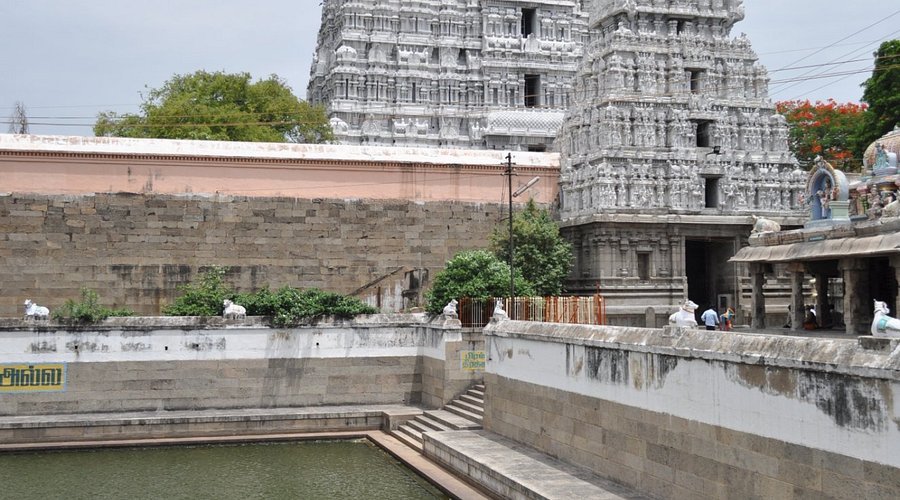
Visiting Thiruvannamalai Temple, also known as Annamalaiyar Temple, is not just a religious journey—it’s a deeply transformative spiritual experience. Nestled at the base of the sacred Arunachala Hill, the temple radiates divine energy that has drawn sages, seekers, and pilgrims for centuries.
Whether you’re attending a vibrant festival like Karthigai Deepam, walking the 14-km Girivalam path under a full moon, or silently meditating in the early morning hours, the temple offers a sacred atmosphere that uplifts the soul. Its towering gopurams, ancient architecture, and ritualistic rhythms carry the weight of Tamil Nadu’s rich Shaivite traditions.
For first-time visitors, the blend of cultural immersion, spiritual insight, and architectural wonder makes this temple an unforgettable destination. Prepare with humility, respect the temple’s customs, and open your heart—you may leave Thiruvannamalai with much more than you came for.
FAQs
1. What is Thiruvannamalai Temple famous for?
It is one of the Pancha Bhoota Sthalams, representing the element of fire (Agni). The temple is famous for Karthigai Deepam, where a flame is lit atop Arunachala Hill, symbolizing Lord Shiva’s cosmic light.
2. Is Girivalam compulsory when visiting the temple?
No, it’s optional, but many devotees perform the Girivalam (circumambulation) as a spiritual practice for blessings, especially on Pournami (full moon) nights.
3. How long does Girivalam take?
The 14-km path typically takes about 3 to 5 hours depending on your pace and crowd conditions.
Q 4. Can non-Hindus visit Thiruvannamalai Temple?
Yes, the outer areas of the temple are open to all, but non-Hindus may not be allowed inside the inner sanctum. Visitors are expected to dress modestly and follow temple etiquette.
Q 5. Are there special rituals or poojas I should attend?
Yes, the early morning Ushakalam Pooja and evening Sayaraksha Pooja are deeply spiritual. Full moon and festival days offer unique experiences.
Q6. Is photography allowed in the temple?
Photography is not allowed inside the main sanctum and inner areas. However, you can take pictures in the outer corridors and around the temple premises.
Q7. Are there good places to stay near the temple?
Yes, there are budget lodges, guest houses, and ashrams near the temple and along the Girivalam path. It’s best to book early during festivals.
Q 8. How can I reach the temple from Chennai or Bengaluru?
Thiruvannamalai is around 200 km from both cities. You can travel via train, bus, or taxi. The nearest railway station is Thiruvannamalai (TNM).
Q 9. What are some nearby attractions?
Nearby attractions include Ramana Maharshi Ashram, Virupaksha Cave, Seshadri Swamigal Ashram, and Skandashramam.
Q 10. Is there a dress code for visiting the temple?
Yes. Modest, traditional clothing is expected. Men may wear dhoti or pants; women should wear sarees or salwar kameez. Avoid sleeveless tops and shorts







